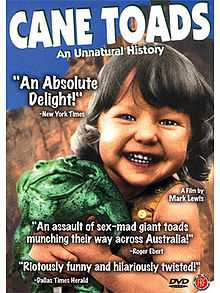Cane Toads: An Unnatural History
| Cane Toads: An Unnatural History | |
|---|---|
 | |
| Directed by | Mark Lewis |
| Written by | Mark Lewis |
| Music by | Martin Armiger |
| Cinematography |
Jim Frazier Wayne Taylor |
| Edited by | Lindsay Frazer |
Release dates | 9 June 1988 (Australia), 11 September 1988 (Canada), 30 September 1988 (USA, limited) |
Running time | 47 minutes |
| Country | Australia |
| Language | English |
Cane Toads: An Unnatural History (1988) is a 47-minute documentary film about the introduction of Cane Toads to Australia. Cane Toads were introduced to Australia with the aim of controlling a sugar cane pest, the cane beetle, but they over-multiplied and became a serious problem in the Australian ecosystem. It is often humorous, and is used in high schools and colleges as a complement to curricula in biology, ecology, environmental science, anthropology, geography, and communication. It was filmed in Cairns and Gordonvale in Queensland.
The film was nominated for a BAFTA Film Award for Best Short Film.[1] It is distributed in the United States by Radio Pictures.
Unusual for a film considered a cult classic, Cane Toads performed very well during its theatrical release. For almost 20 years Cane Toads: An Unnatural History held the title of top grossing non-IMAX documentary for the Australian box office. It remains easily in the top ten today even with the IMAX films included. Released in March 1988, it is recording as bringing in $613,910 Australian dollars (not adjusted for inflation).[2]
Production elements
One of the film’s aesthetic and storytelling “innovations” was to try and tell much of the story from the cane toads’ point of view. This was achieved by a number of extremely low angle shots. Lewis’ goal was to give a voice to the toads who were at the center of so much controversy, and “create some sympathy for this animal that was so widely reviled”.[3]
Funding and distribution
The film was funded by Film Australia. It was shown in theatres and currently still ranks high in Australian box office records for documentaries. The film was also released on DVD or VHS in Australia, the USA, and the UK (IMDb, 2011a). Excerpts of the film are also available online as teaching aids. Based on Internet comments, the film is still shown in middle school, high school, and college classrooms and is well received. Production Company: Film Australia. Distributors: First Run Features (1999) (USA) (VHS); First Run Features (2001) (USA) (DVD); Umbrella Entertainment (2003) (Australia) (DVD); Unique Films (UK) (VHS) (IMDb, 2011a).
Sequel
A sequel called Cane Toads: The Conquest premiered at the 2010 Sundance Film Festival.[4] A completely new feature, almost twice as long as the first film, it is said to be the first Australian 3D digital film.[5] In the years since the first film, the cane toad "multiplied alarmingly" to become a "seemingly unstoppable menace".[6] The sequel/remake was released in Sydney in June 2011. Both films were written and directed by Mark Lewis. Their cultural impact and moral complexity were explored in an essay by Elizabeth Farrelly.[7]
References
- ↑ not applicable (1989). "BAFTA Database". 1989 Awards. BAFTA. Retrieved 28 May 2014.
- ↑ "Australia: Top documentaries of all time".
- ↑ Lewis, Mark (2010). Cane toads and other rogue species. New York: PublicAffairs. pp. 25–26. ISBN 978-1-58648-706-5.
- ↑ "Cane Toads: The Conquest". B-Side. Retrieved 13 April 2010.
- ↑ Review by Paul Byrnes in The Sydney Morning Herald 2011-06-02
- ↑ Review by David Stratton in The Australian 2011-06-04
- ↑ Farrelly, Elizabeth (2 June 2011). "This beast isn't going anywhere". The Sydney Morning Herald. Retrieved 2 June 2011.
Australian Broadcasting Corporation (ABC). (n.d.). Cane Toads – An Unnatural History (1987). ABC.net.au. Retrieved from http://www.abc.net.au/aplacetothink/html/cane_toads.htm
IMDb. (2011a). Cane Toads: An Unnatural History (1988): Company credits. The Internet Movie Database (IMDb). Retrieved 30 November 2011, from http://www.imdb.com/title/tt0130529/companycredits
IMDb. (2011b). Cane Toads: An Unnatural History (1988): Filming locations. The Internet Movie Database (IMDb). Retrieved 30 November 2011, from http://www.imdb.com/title/tt0130529/locations
IMDb. (2011c). Mark Lewis. The Internet Movie Database (IMDb). Retrieved 30 November 2011, from http://www.imdb.com/name/nm0507509/
Lewis, M. (2010). The making—and the meaning—of Cane Toads: The Conquest. Cane toads and other rogue species (pp. 19–32). New York: PublicAffairs.
Mitman, G. (1999). Epilogue. Reel nature: America's romance with wildlife on films (pp. 203–208). Cambridge, Mass.: Harvard University Press.
Morris, E. (n.d.). Eye Contact: Interrotron. Errol Morris. Retrieved 20 November 2011, from http://errolmorris.com/content/eyecontact/interrotron.html
Murray, R. L., & Heumann, J. K. (2009). Ecology and popular film: Cinema on the edge. Albany: State Univ. of New York Press.
Petterson, P. B. (2011). Cameras into the wild: a history of early wildlife and expedition filmmaking, 1895–1928. Jefferson, N.C.: McFarland.
Screen Australia. (n.d.). Australia: Top documentaries all time. Screen Australia. Retrieved 30 October 2011, from http://www.screenaustralia.gov.au/research/statistics/mrboxtopdoco.asp
SEWPaC. (n.d.). Invasive species in Australia – Fact sheet. Australian Government Department of Sustainability, Environment, Water, Population and Communities (SEWPaC). Retrieved 30 November 2011, from http://www.environment.gov.au/biodiversity/invasive/publications/species.html
Weber, K. (2010). Cane toads and other rogue species. New York: PublicAffairs.
West, Jackson. (2007). Top Ten Online Filmmaking Techniques. Gigaom. Retrieved from http://gigaom.com/video/top-ten-online-filmmaking-techniques/